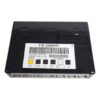Restore Your Cadillac’s Electrical System with a Plug-and-Play BCM
Are you chasing electrical gremlins in your 2006-2011 Cadillac DTS? Flickering lights, windows that won’t cooperate, a security system that has a mind of its own, or strange warning messages on the dash are classic signs of a failing Body Control Module (BCM). As the central nervous system for your vehicle’s body electronics, a faulty BCM can cause a cascade of frustrating and seemingly unrelated issues. Stop the guesswork and replace the root cause of the problem with a reliable, pre-programmed BCM.
This isn’t just a replacement part; it’s a complete solution. We take the hassle out of the repair by programming this module specifically to your Cadillac’s VIN before it ships. This means you get a part that’s ready to install right out of the box, loaded with the latest GM software updates. You’ll avoid a costly trip to the dealership for programming, saving you both time and money. This is the most direct path to getting your DTS back to its fully-functional, luxurious self.
From the Diagnostic Bay: The Case of the Spooked DTS
I remember a 2009 DTS that rolled into my shop with a laundry list of complaints. The owner was frustrated because the interior lights would pulse randomly, the radio would shut off, and the “Service Theft System” message kept appearing. He’d already replaced the battery to no avail. After connecting my scan tool, I saw multiple communication loss codes (U-codes) with various modules. This pointed directly to a network issue, and in these GM platforms, the BCM is the central hub. After confirming power and ground to the original BCM were good, we installed one of our pre-programmed units. Instantly, all the strange electrical behavior stopped. The car was back to normal, and the customer was relieved to have a definitive fix without a massive dealership bill.
Is Your Cadillac Showing These Symptoms?
A failing BCM can manifest in numerous ways. If you’re experiencing any of the following, it’s a strong indicator that your 2006-2011 DTS BCM is the culprit:
- ✔ Erratic power windows, door locks, or mirrors.
- ✔ Interior or exterior lights that flicker, stay on, or don’t work at all.
- ✔ “Service Theft System” or other security-related warnings on the instrument cluster.
- ✔ Unresponsive key fob or push-to-start system.
- ✔ Malfunctioning climate controls or radio.
- ✔ Multiple communication error codes (e.g., U0140, U0155, U0100) stored in the system.
- ✔ A no-start or intermittent starting condition where the engine cranks but won’t fire up.
Your Straightforward DTS BCM Installation Guide
Installing your new BCM is a manageable job for a confident DIYer. In the 2006-2011 Cadillac DTS, the BCM is located behind the glove box on the right-hand side of the center dash.
- Safety First: Always disconnect the negative terminal from your vehicle’s battery and wait a few minutes for the system to fully discharge before starting work.
- Access the Module: Open and remove the glove box. You may need to release retaining tabs or remove a few screws to get it completely out of the way. You should now see the BCM.
- Disconnect and Remove: Carefully unplug the electrical connectors from the old BCM. They have locking tabs that need to be depressed. Once disconnected, unbolt or unclip the module from its mounting bracket and remove it from the vehicle.
- Install the New BCM: Mount your new, pre-programmed BCM onto the bracket and plug in all the electrical connectors, ensuring they click securely into place.
- Final Steps: Reinstall the glove box and reconnect the negative battery terminal. Start the vehicle to confirm that the primary functions are restored.
Important Post-Installation Note: While this module is programmed for your vehicle, some models may require additional relearn procedures. If your airbag light is on, a professional scan tool is needed to perform the “Setup SDM Primary Key in BCM” procedure. A “Brake Pedal Position Relearn” might also be necessary for proper brake light and traction control operation. Always consult a factory service manual for specifics.
Verified Vehicle Compatibility
This Body Control Module is a direct replacement for a wide range of GM vehicles and part numbers. Please confirm your vehicle is on the list below. This unit replaces part numbers: 10382479, 15093910, 15276271, 15299986, 15819552, 15828601, 15837419, 15872388, 15872421, 15880684, 15921352, 15921353, 15948438, 15948439, 20815898, 20839063, 20864767, 20864768, 20921435, 20921436, 20935349, 22860591, 25826124, 25826125, 25847588, 25847589, 25892622, 25910474, 25934762, 25934763, 95151084.
And many other GM models including Acadia, Enclave, Traverse, Equinox, Tahoe, Yukon, Suburban, Escalade, Impala, Lucerne, Express/Savana Vans, and more. Please check the full fitment list for your specific model and year.
Frequently Asked Questions
Frequently Asked Questions
Do I need to send my old BCM back?
No, there is no core charge for this part. You can keep your original module, which can be helpful for reference or if you ever decide to revert to the original state.
What information do you need to program the BCM?
After you place your order, you will need to provide us with your vehicle’s 17-digit VIN (Vehicle Identification Number). This allows us to load the correct software and settings for your specific car.
Is this a difficult part to install myself?
For someone with basic mechanical skills, this is a very manageable installation. The primary challenge is accessing the module’s location. Since we handle the programming, no special computer equipment is needed for the main installation.
What if my airbag light comes on after installation?
This can happen on some vehicles. It means the new BCM needs to be synced with the airbag system’s SDM module. This requires a professional-grade scan tool to perform the ‘Setup SDM Primary Key in BCM’ procedure. A local repair shop can typically perform this service.
Will this fix my ‘Service Theft System’ message?
In many cases, yes. The BCM is integral to the vehicle’s anti-theft and security system. A failing BCM is a very common cause of this specific warning message on the Cadillac DTS and other GM vehicles.


